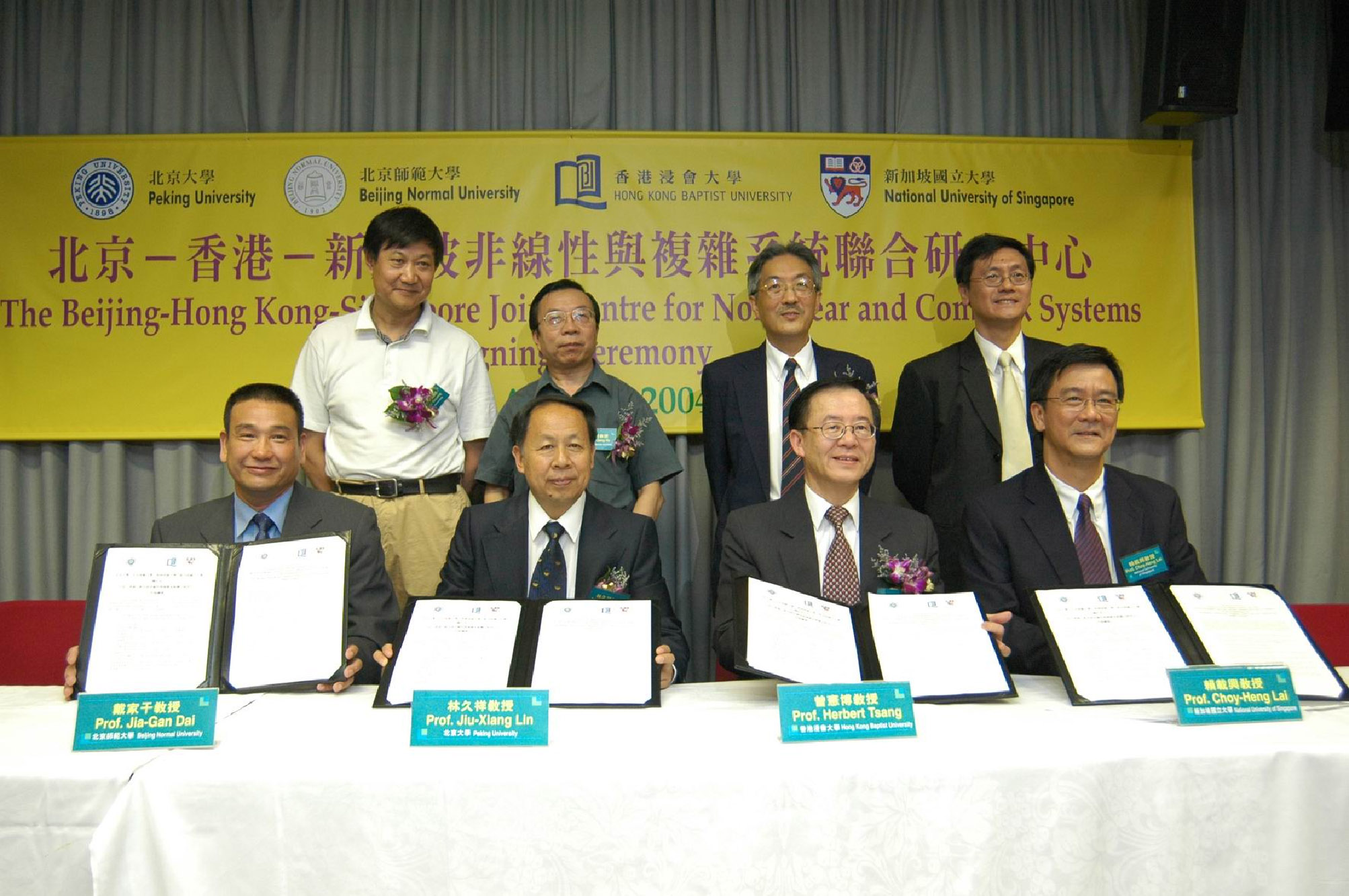 |
The Beijing–HongKong–Singapore Joint Centre for Nonlinear and Complex Systems, Beijing Normal University Volume 8, Number 3 |
|---|
Location
Beijing Normal University
Beijing 100875, China
Website(s): http://cncs.bnu.edu.cn/ or http://physics.bnu.edu.cn/
Overview
 The BHS Joint Centre for Nonlinear and Complex Systems was founded in 2004. The alliance has been dubbed the “Asian Dragon League”, which was formed by scientists working on nonlinear physics and complexity in Peking University, Beijing Normal University (BNU), Hong Kong Baptist University, and National University of Singapore, aiming to nourish research in nonlinear and complex systems, and boost Asia’s competitiveness.
The BHS Joint Centre for Nonlinear and Complex Systems was founded in 2004. The alliance has been dubbed the “Asian Dragon League”, which was formed by scientists working on nonlinear physics and complexity in Peking University, Beijing Normal University (BNU), Hong Kong Baptist University, and National University of Singapore, aiming to nourish research in nonlinear and complex systems, and boost Asia’s competitiveness.
The BNU branch of the Joint Centre is a leading group focusing on topics of nonlinear dynamics and nonequilibrium statistical physics. The current research at BNU is led by Professors Gang Hu, Zhigang Zheng, and other five associate professors working on nonlinear dynamics, statistical physics and experimental nonlinear physics. The Centre also has numerous distinguished scientists such as P. Hanggi at Augsburg, Michael Cross at Caltech, Bambi Hu at Houston, Yingcheng Lai at ASU, Chinkun Hu at Taiwan, Baowen Li at NUS as guest professors. There are 15-20 PhD and graduate students in the Centre.
The group has made key achievements in a number of topics on nonlinear dynamics, complexity and statistical physics, such as stochastic resonance, controlling spatiotemporal chaos, chaos synchronization, secure communications, complex networks, pattern formations, collective directed transport, and heat conduction in low-dimensional systems. These advances have been published in three monographs and over 400 scientific papers on prestigious physical journals with over 3000 citations by international colleagues.
Currently the BNU group is undertaking a number of research foundations including the 973 project, National Natural Science Foundation of CHINA and other research programs. Currently the Centre is conducting a BNU innovative group (statistical and nonlinear physics) from 2007 led by Prof. Zhigang Zheng.
Key Contact
Professor Zhigang Zheng
Acting director, The BHS Joint Centre (BNU Branch)
Telephone: +86-10-5880-5147
E-mail: zgzheng@bnu.edu.cn
Research Topics and Projects
Pattern Formation and Spatiotemporal Chaos: Studying the formation of spatial structures in nonequilibrium systems which ranges from physics, chemistry, to biology and ecology. It has been revealed that the thermal branch of a system may lose its stability and evolves to an ordered and structural state through self organization. Mathematically, dynamics of the nonequilibrium transition is based on partial differential equations (reaction-diffusion equations) or coupled ordinary differential equations. The motivation of the BNU group in studying this topic is to provide more insightful understandings of transitions among different pattern states and spatiotemporal chaos by using different PDE or coupled ODE models and nonlinear analysis tools. Moreover, members of the Centre have successfully obtained important results in Complex Ginzburg-Landau Equations, dynamics of spiral waves, and spatiotemporal chaos. Extensive studies have also been made to cardiac dynamics, and schemes in eliminating the spiral wave in cardiac tissues have been proposed.
Chaos Synchronization and Chaos Control: Chaotic systems can be synchronized when they are coupled to each other or driven by other systems. Moreover, chaotic motion can be well controlled or manipulated by OGY or other control schemes. Synchronization is an old phenomenon discovered in physics, and it has been found to emerge in a lot of systems with rhythmic dynamics. Different from synchronous motions of coupled limit cycles, chaos synchronization has richer manifestations such as identical/complete, generalized, phase, lag, and measure synchronizations. The group has done numerous work related to this topic, covering different forms of synchronization states, relations among different forms of synchronization, Kuramoto models, and other collective dynamics.
Experimental Nonlinear Physics: There have been numerous experimental explorations on nonlinear dynamics. In recent years experiments have become more important due to the extensive applications of chaotic dynamics such as synchronization, control, secure communication and even transport. The BNU group has made contributions on experimental studies of stochastic resonance, chaos control, secure communications and physical random number generators. Currently there are still a number of interesting experimental issues such as delayed optical dynamics, chimera states and so on.
Complex Networks: Studies of complex networks have become a hot topic since the pioneering work of Watts and Strogatz on small-world networks and Albert and Barabasi on scale-free networks. In recent years the explorations on networks have been made to complicated and collective dynamics on networks. It is significant to study the interaction between nonlinear dynamics and network structures. The BNU group has made achievements on topics including synchronous dynamics on networks, propagation dynamics on small-world and scale-free networks, network topology identification based on nonlinear dynamics, and so on.
Nonequilibrium Statistical Physics: Systems going beyond equilibrium states may exhibit abundant behaviors. The Centre is currently focusing on the following topics: (1) Noise-induced nontrivial dynamics of nonlinear systems, stochastic resonance; (2) The dynamical foundation of statistical mechanics and ergodic theory; (3) Statistical mechanics of systems with only a few degrees of freedom; (4) Free-energy relation, fluctuation theorem and Jarzynsky equality; (5) Heat conductions, energy transport, wave dynamics, thermal diode, thermal rectifications in low-dimensional lattices.
Biophysics: Knowledge from statistical physics and nonlinear physics can be well applied to explorations of various issues in biology. Various rhythms and their collective behaviors in biological systems have been revealed, and these rhythms can be well modeled in terms of nonlinear oscillators, and the collective phenomena can be interpreted as synchronous oscillations of coupled oscillators. On the other hand, the structures and evolutions of biological systems such as proteins, genes, and neurons have been microscopically described by complex network dynamics. Moreover, molecular motors can be modeled in terms of the scenario related to Brownian ratchets. Scientists of the BNU Centre have done numerous work on synchronous dynamics of coupled limit cycles, ecology, Gene Regulatory Networks, collective directed transport and molecular motors.
Econophysics: Economical groups and activities can be considered as highly complicated but well-organized systems and dynamics. Although various economic data (such as stock-market indices, foreign-exchange rates, and so on) exhibit adequate random fluctuations, these stochastic behaviors are distinctly different from purely stochastic processes (e.g., Brownian motion), i.e., anomalous diffusion. In financial markets, the topology network analysis is a widely used technical tool and provides efficient methods to describe their structural and market properties. Members in the Centre have started studies of the network structural properties and evolution dynamics of the foreign-exchange market and obtained interesting results, which should shed light on the understanding of financial activities.